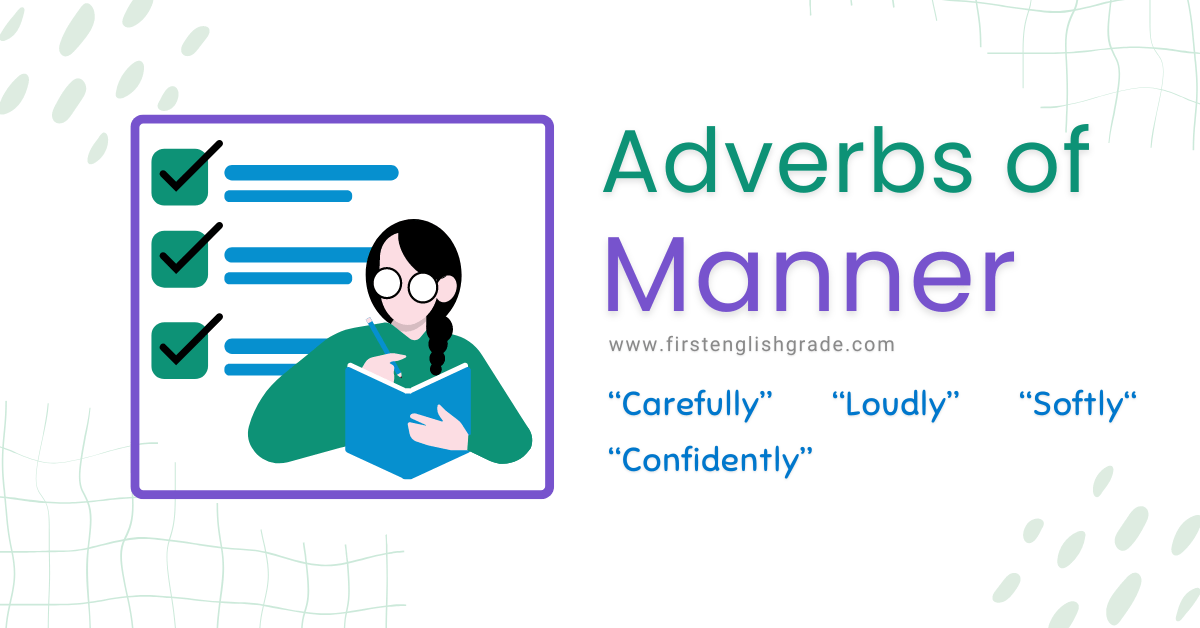Have you ever wondered how to make your sentences more descriptive, engaging, and, well, just more interesting? That’s exactly what adverbs of manner are here for. Adverbs of manner add depth and clarity to sentences by specifying the method, style, or intensity of an action. These adverbs help convey the manner in which an action is executed, allowing for more vivid and precise communication in the English language.
Let’s discover the magic of adverbs of manner, and learn the skills to use them effectively in everyday conversation.
What Are Adverbs of Manner?
Adverbs of manner are the adverbs that describe how an action is performed or the way in which something happens. They provide additional information about the verb in a sentence, answering the question of “how” the action is carried out. Let’s dive into some examples:
- She sings beautifully.
- He speaks loudly.
- They danced gracefully.
In each of these sentences, the adverbs of manner (beautifully, loudly, gracefully) enhance our understanding of how the actions are carried out. Without them, our sentences would be quite bland, right?
Adverbs of Manner Examples
Let’s take a look at some adverbs of manner examples:
| Adverb | Example Sentence |
| Carefully | He handled the fragile vase carefully. |
| Loudly | The rock concert was playing loudly. |
| Softly | Speak softly in the library. |
| Happily | They celebrated their victory happily. |
You can use these adverbs to paint a clearer picture of actions in your sentences. Are you starting to see how adverbs of manner work?
List of Adverbs of Manner
Here’s the list of adverbs of manner in English:
| Adverb | Adverb |
| Quickly | Slowly |
| Carefully | Loudly |
| Quietly | Cautiously |
| Happily | Sadly |
| Silently | Noisily |
| Politely | Rudely |
| Well | Badly |
| Tightly | Loosely |
| Angrily | Calmly |
| Excitedly | Nervously |
| Confidently | Gently |
| Violently | Easily |
| Hard | Softly |
| Suddenly | Gradually |
| Seriously | Playfully |
| Beautifully | Ugly |
| Seriously | Happily |
| Sadly | Completely |
| Partially | Entirely |
| Carelessly | Briefly |
How to Use Adverbs of Manner
Using adverbs of manner effectively can greatly enhance your English communication. To ensure you wield them with precision, let’s explore the different aspects of their usage:
1. Placement in a Sentence
Adverbs of manner can be positioned in various places within a sentence, depending on its structure. Here are the primary positions:
a. Before the main verb:
- She quickly solved the puzzle.
- They happily sang their favorite songs.
In these examples, the adverbs “quickly” and “happily” come before the main verbs “solved” and “sang” to describe how the actions are performed.
b. After the auxiliary verb (when present):
Adverbs of manner can also be placed after the auxiliary verb in some cases, particularly when the auxiliary verb is used in progressive tenses. For example:
- He was speaking loudly. (Progressive tense with the adverb “loudly” following the auxiliary verb “was.”)
- They have always played well together. (Perfect tense with the adverb “always” preceding the adverb of manner “well.”)
While this placement is less common, it’s still grammatically correct and can be used when appropriate.
c. At the end of the sentence:
Adverbs of manner can also be placed at the end of a sentence, especially when you want to emphasize the manner of an action. For example:
- They danced all night, gracefully. (Emphasizing the graceful manner of their dance)
- She spoke about the project, passionately. (Emphasizing the passionate manner of her speech)
In these instances, the adverb of manner appears at the end of the sentence, providing a final emphasis on how the action was performed.
2. Modifying Verbs and Adjectives
Adverbs of manner primarily modify verbs, indicating how an action is performed. However, they can also modify adjectives, adding depth to descriptions. For example:
- She played the piano beautifully. (Modifying the verb “played.”)
- The sunset was incredibly beautiful. (Modifying the adjective “beautiful.”)
In the first sentence, “beautifully” describes how she played the piano, while in the second sentence, it enhances the adjective “beautiful” to provide a more detailed description of the sunset.
3. Avoiding Overuse
While adverbs of manner are valuable, using them excessively can clutter your writing or speech. Instead, employ them when they genuinely contribute to the meaning or tone of your message. For instance, saying, “He ran quickly to catch the bus,” is appropriate because it specifies the manner of running. However, “He quickly and energetically ran really fast to catch the bus,” is redundant and excessive.
4. Expressing Degree
Adverbs of manner can also be used to express the degree or intensity of an action. They allow you to convey how strongly or mildly an action is performed. Here’s a closer look:
- Mild Degree: Adverbs can describe an action with a gentle or mild degree:
- She smiled kindly. (Her smile was gentle and compassionate.)
- He spoke softly. (His voice had a gentle, quiet quality.)
In these examples, “kindly” and “softly” indicate a mild or moderate degree of the respective actions.
- Strong Degree: Adverbs can intensify the manner of an action to express a stronger or more emphatic degree:
- She smiled warmly. (Her smile was notably warm and inviting.)
- They sang enthusiastically. (Their singing was filled with excitement and energy.)
In these cases, “warmly” and “enthusiastically” emphasize a higher level of warmth and enthusiasm in the actions.
- Extreme Degree: Adverbs can be used to convey an extreme or maximum degree of an action:
- He ran extremely quickly. (He ran at the utmost speed.)
- She whispered almost inaudibly. (Her whisper was nearly impossible to hear.)
Here, “extremely” and “almost” highlight the extremeness of the manner in which the actions are performed.
Adverbs of Manner Exercises
Instructions: Fill in the blanks with the appropriate adverb of manner. Choose from the adverbs provided in the table below.
| Adverbs to Choose From | ||||
| loudly | heartily | diligently | quickly | gracefully |
| happily | carefully | wildly | beautifully | efficiently |
- She played the piano __________.
- He completed the assignment __________.
- They spoke to the crowd __________.
- He sings __________, making everyone smile.
- She walked down the aisle __________.
- They solved the puzzle __________.
- The children laughed __________ at the clown’s antics.
- He worked __________, finishing the project ahead of schedule.
- She studied English __________ and made great progress.
- The wind howled __________ outside the window.
Answer Key:
- She played the piano beautifully.
- He completed the assignment quickly.
- They spoke to the crowd loudly.
- He sings happily, making everyone smile.
- She walked down the aisle gracefully.
- They solved the puzzle carefully.
- The children laughed heartily at the clown’s antics.
- He worked efficiently, finishing the project ahead of schedule.
- She studied English diligently and made great progress.
- The wind howled wildly outside the window.
Frequently Asked Questions (FAQs) About Adverbs of Manner
Q1: What is an adverb of manner?
An adverb of manner is a word that describes how an action is performed or the way in which something happens. It provides additional information about the verb in a sentence, answering the question of “how” an action is carried out.
Q2: Can you give some examples of adverbs of manner?
Certainly! Here are a few examples of adverbs of manner: “quickly,” “loudly,” “carefully,” “happily,” and “gracefully.” These adverbs tell us how an action is done.
Q3: Where can adverbs of manner be placed in a sentence?
Adverbs of manner can be placed in different positions within a sentence, including:
–Before the main verb (e.g., She sings beautifully).
–After the auxiliary verb, when present (e.g., He was speaking loudly).
–At the end of the sentence (e.g., They danced all night, gracefully).
Q4: Can adverbs of manner modify adjectives as well as verbs?
Yes, adverbs of manner can also modify adjectives. For example, “The sunset was incredibly beautiful.” Here, “incredibly” modifies the adjective “beautiful” to provide a more detailed description.
Q5: Are there any common mistakes to avoid when using adverbs of manner?
Yes, common mistakes include overusing adverbs, misplacing them in a sentence, and using them redundantly. It’s important to use adverbs of manner where they genuinely contribute to the meaning or tone of your message.




